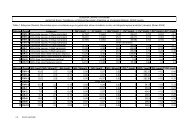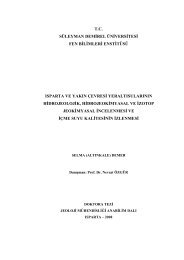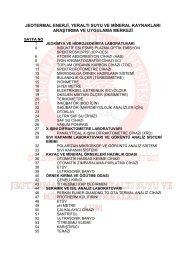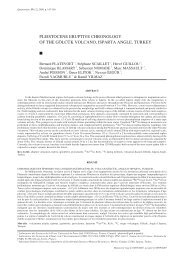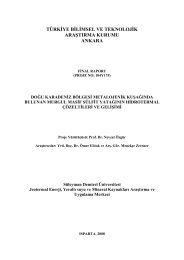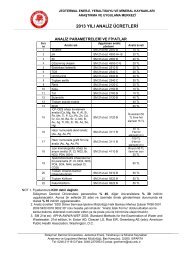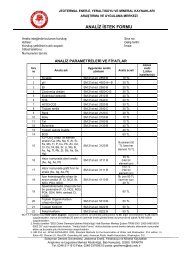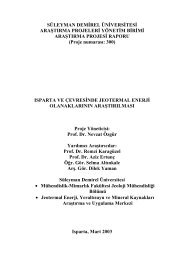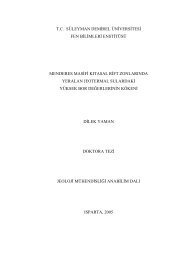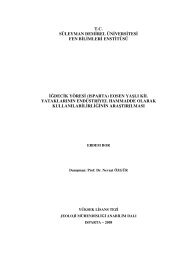2.4.5 StatisticsNumber of Team Members involved in this project: 5Number of Team Members under 35: 2Number of Team Members who have individually received grants in INTAS projects: 23 OBJECTIVES3.1 RESEARCH OBJECTIVESThe Alpide paleo-isl<strong>and</strong> <strong>arc</strong> of Pontides <strong>and</strong> Southern Cauc<strong>as</strong>us is one of the best are<strong>as</strong> inEur<strong>as</strong>ia to examine the development of volcanism above a subduction zone <strong>and</strong> the formationof <strong>related</strong> mineralisation. Economic volcanic <strong>as</strong>sociated m<strong>as</strong>sive sulphide deposits (VMS) <strong>and</strong>epigenetic polymetallic gold-bearing deposits <strong>as</strong> well <strong>as</strong> porphyry copper-gold deposits occurin the volcanic sequences.The objectives of the Project are also economic, aiming at developing realistic geologicalmodels to aid exploration for the mining industry in an underdeveloped area. Environmentalmodels are also required at Murgul (Pontides) <strong>as</strong> well <strong>as</strong> Madneuli <strong>and</strong> Shamlug (LesserCauc<strong>as</strong>us) to underst<strong>and</strong> the impact of these mines.The Project proposes detailed investigation (petrological, paleo-volcanological, lithofacies,geochemical <strong>and</strong> mineralisation) of volcanic structures of the western (Turkey) <strong>and</strong> thee<strong>as</strong>tern (Georgia, Armenia) sections of the paleo-isl<strong>and</strong> <strong>arc</strong>. The main objectives of theinvestigation are following:1. Reconstruction of volcanic structures of both the western <strong>and</strong> e<strong>as</strong>tern sections of thepaleo-<strong>arc</strong> (sections are distinguished by volcanic sedimentation <strong>and</strong> ore<strong>mineralization</strong>).2. Determination of the paragenetic relation of <strong>magmatism</strong> with <strong>mineralization</strong>.3. Compilation of volcanological maps (1:5 000 - 1:25 000 scales) with VMS deposits(Asikoy <strong>and</strong> Cayeli Cerattepe -Pontides) <strong>and</strong> epigenetic b<strong>as</strong>e metal deposits (Bolnisi<strong>and</strong> Alaverdy mining districts of Eesser Cauc<strong>as</strong>us). The are<strong>as</strong> contain different stylesof <strong>mineralization</strong>.4. Development of geologic-genetic <strong>and</strong> exploration models of volcanogenic <strong>and</strong>porphyry deposits with different styles of <strong>mineralization</strong>.5. Evaluation of ore potential of the paleo-isl<strong>and</strong> <strong>arc</strong> volcanic structures.6. Investigation of environmental impact in the vicinity of producing mines3.2 Background <strong>and</strong> JustificationBackgroundThe Pontide-South Cauc<strong>as</strong>ian paleo-isl<strong>and</strong> <strong>arc</strong> is an extension of the well-mineralisedCarpathian system. The <strong>arc</strong> can be divided into two sections that are separated by a, later,thick sequence of Neogene volcanics. Structural facies investigations (Yilmaz et al. 2000)determined, that the western (Pontides) <strong>and</strong> e<strong>as</strong>tern (Lesser Cauc<strong>as</strong>us) sectors differ in thecharacter of their geodynamic development, the nature of the volcanism, <strong>as</strong> well <strong>as</strong> in theintensity of volcanic activity <strong>and</strong> styles of <strong>mineralization</strong>.The <strong>arc</strong> is bounded on the south by continental slivers, of probable Gondwana origin, whichpossibly also form the b<strong>as</strong>ement of the <strong>arc</strong> (Robinson, 1997). Volcanism in the western part ofthe <strong>arc</strong> is dominated by a thick <strong>and</strong>esite sequence of upper Cretaceous age. Tri<strong>as</strong>sic volcanismis in the form of allocthonous are<strong>as</strong> of b<strong>as</strong>ic volcanics (Ustaomer & Robertson, 1993). Incontr<strong>as</strong>t, the Lesser Cauc<strong>as</strong>us sector h<strong>as</strong> <strong>and</strong>esite volcanism of both Bajocian <strong>and</strong> upperCretaceous age. Following collision a thick (particularly in W Georgia) section of Eocenevolcanics, w<strong>as</strong> generated in a rift environment. Although geophysical data indicate that the E
Pontide section continues to the NE, the exact nature of the correlation with the LesserCauc<strong>as</strong>us is in doubt. Yilmaz et al. (2000) proposed a continuation along strike. In contr<strong>as</strong>t,Akdeniz et al, (2000), suggested that a major fault offsets the e<strong>as</strong>tern Pontides <strong>and</strong> cor<strong>related</strong>a section around Giimushane with the Bolnisi area.In contr<strong>as</strong>t to the Carpathian <strong>arc</strong>, volcanic-<strong>as</strong>sociated m<strong>as</strong>sive sulphide deposits (VMS) arethe dominant type of economic deposit, although vein Au deposits <strong>and</strong> porphyries have been,<strong>and</strong> are being, investigated, <strong>as</strong> well <strong>as</strong> minor skarns <strong>and</strong> Mn deposits (Engin et a/.,2000; Moonet al, 2001).VMS deposits occur in a variety of forms: Asikoy (Cyprus style) (Guner, 1980), Kuroko styledeposits such <strong>as</strong> Cayeli (Hobbs, 2000) <strong>and</strong> Lahanos; gold-rich variants such <strong>as</strong> Cerattepe(Ciftehan & O'Brien 1998) (Pontides) <strong>and</strong> Madneuli (Lesser Cauc<strong>as</strong>us); epigenetic styles such<strong>as</strong> Murgul (Pontides) <strong>and</strong> Kafan, Alaverdy <strong>as</strong> well <strong>as</strong> barite-rich deposits in the Bolnisi district(Lesser Cauc<strong>as</strong>us).The re<strong>as</strong>on for the generation of the different styles of deposits is not understood in detail butis probably due to differences in water depth, sources of fluids (magmatic or sediment) <strong>and</strong>fluid pathways. Deposits such <strong>as</strong> Asikoy, Cayeli <strong>and</strong> Lahanos probably represent deep- watersettings where<strong>as</strong> Alaverdy <strong>and</strong> Madneuli probably formed in shallower water sediments. Fluidinclusion investigations at Madneuli give temperature for copper ores of 370-260° C, forbarite-polymetallic ores on 270°-180°C (Kekelia et. al, 1993) <strong>and</strong> deep drilling h<strong>as</strong> cutintrusives underneath the deposit. The Murgul ores currently mined are predominantly of thestockwork type <strong>and</strong> have been suggested <strong>as</strong> transitional to porphyry coppers deposits byOzgiir (1993). Gold ocurs in many VMS deposits but deposits such <strong>as</strong> Cerattepe <strong>and</strong>Madneuli appear to have epithermal overprints. More conventional vein Au deposits arepresent both in upper Cretaceous volcanics, such <strong>as</strong> Altintepe, near Fatsa (Curtis, 2002).The larger deposits VMS are very significant. At Cayeli, for example, 7.35 Mt of ore hadbeen mined to 2002 <strong>and</strong> reserves are put at 16.9 Mt of 3.8% Cu, 5.8% Zn, 0.5 g/t Au <strong>and</strong> 47g/t Ag (Inmet Mining, 2003). A further resource of 2.9 Mt is inferred. Madneuli <strong>and</strong> Murgulboth contained >70 Mt of ore before mining <strong>and</strong> Madeuli is currently being mined for gold.The Alaverdy deposits are current under rehabilitation by a private sector group.Porphyry deposits in the <strong>arc</strong> occur in a variety of forms <strong>and</strong> ages. Both Cu-Mo <strong>and</strong> Cu-Autype have been discovered in the Pontides <strong>and</strong> Lesser Cauc<strong>as</strong>us (Ratman et al, 1985). Mooreet al. (1980) suggested a modal age of ~80 Ma for Pontide granitic <strong>magmatism</strong> with laterph<strong>as</strong>es at 45 <strong>and</strong> 25 Ma. Exploration in the Artvin area h<strong>as</strong> defined a Au-rich porphyry,temporally <strong>as</strong>sociated with the rift stage (Gumushane dated <strong>as</strong> Eocene (K/Ar: 51-54 Ma,Rockl 1998). In the Lesser Cauc<strong>as</strong>us, porphyries are present at depth in the Bolnisi area <strong>and</strong>outcrop in the Alverdy district. The younger porphyries in southern Armenia are not <strong>related</strong> tothe Pontide <strong>arc</strong> <strong>and</strong> are not the subject of the current project.The Pontides <strong>and</strong> Lesser Cauc<strong>as</strong>us are relatively deprived are<strong>as</strong> of Turkey <strong>and</strong> Georgia <strong>and</strong>both are<strong>as</strong> are experiencing population outflow. Mining represents an opportunity fordevelopment. However, many previous mines have been responsible for unacceptable impactson the environment. Some information (Akcay <strong>and</strong> Moon, 1999; submitted) provide someinformation on the Pontides. Acid Mine Drainage is a major result of open pit VMS in Turkey<strong>and</strong> is also known from Georgia (DAI, 2003). The eventual impact of mining is a combinationof the nature of deposits <strong>and</strong> mining practice. The modern Cayeli operation h<strong>as</strong> relatively littleimpact because of the disposal of tailings at depth in the Black Sea. Murgul is one of thepollution hot spots within the Black Sea b<strong>as</strong>in <strong>as</strong> there is no tailings facility <strong>and</strong> tailingseventually are deposited in the estuary of the Coruh river on the outskirts of the majorGeorgian city of Batumi.



